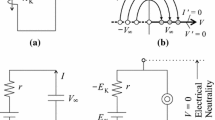Abstract
The excitable nature of a biological cell is manifested in the many voltage gated ion channels that perforate its membrane. The forms of the associated ionic currents, and in particular the functions that govern their kinetics, permit one to distinguish, electrophysiologically, between various cell types. We show, in the context of FitzHugh-Nagumo and Morris-Lecar models and without recourse to voltage or space clamping, that such currents and kinetics may be stably inferred from a cell’s voltage response to a specified input current.
Similar content being viewed by others
References
Agmon-Snir, H. (1995). A novel theoretical approach to the analysis of dendritic transients. Biophys. J. 69, 1633–1656.
Cox, S. J. (1998). A new method for extracting cable parameters from input impedance data. Math. Biosci. 153, 1–12.
Cox, S. J. and L. Ji (2000). Identification of the cable parameters in the somatic shunt model. Biol. Cybern. 83, 151–159.
Cox, S. J. and B. Griffith (2001). Recovering quasi-active properties of dendritic neurons from dual potential recordings. J. Comput. Neurosci., to appear.
FitzHugh, R. (1969). Mathematical models of excitation and propagation in nerve, in Biological Engineering, H. P. Schwan (Ed.), New York: McGraw-Hill.
Keener, J. and J. Sneyd (1998). Mathematical Physiology, New York: Springer-Verlag.
Miller, R. K. and A. N. Michel (1982). Ordinary Differential Equations, New York: Academic Press.
Murio, D. A., C. E. Mejia and S. Zhan (1998). Discrete mollification and automatic numerical differentiation. Comput. Math. Appl. 35, 1–16.
Pilant, M. and W. Rundell (1988). Fixed-point methods for a nonlinear parabolic inverse coefficient problem. Commun. Partial Diff. Equ. 13, 469–493.
Rall, W., R. E. Burke, W. R. Holmes, J. J. B. Jack, S. J. Redman and I. Segev (1992). Matching dendritic neuron models to experimental data. Physiol. Rev. 172, S159–S186.
Vanier, M. C. and J. M. Bower (1999). A comparative survey of automated parameter—search methods for compartmental neural models. J. Comput. Neurosci. 7, 149–171.
Willms, A. R., D. J. Baro, R. M. Harris-Warrick and J. Guckenheimer (1999). An improved parameter estimation method for Hodgkin—Huxley models. J. Comput. Neurosci. 6, 145–168.
Author information
Authors and Affiliations
Corresponding author
Rights and permissions
About this article
Cite this article
Cox, S.J., Ji, L. Discerning ionic currents and their kinetics from input impedance data. Bull. Math. Biol. 63, 909–932 (2001). https://doi.org/10.1006/bulm.2001.0250
Received:
Accepted:
Issue Date:
DOI: https://doi.org/10.1006/bulm.2001.0250




